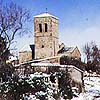


| Valle de Puértolas - Puyarruego |
| Home | Wildlife | Dung beetles | Species list |
 |
 |
 |
|
| Nederlands | Dung beetles |
Castellano |
| People come to the region to visit the Ordesa National Park, to climb the Monte Perdido, to do some canyoning or bird watching (see our bird list), to hunt for
plants and butterflies; in other words they come to enjoy a stay in a habitat they consider natural. An important part of the mountain landscape however would perish without
the intervention of humans and their cattle.
Let's try to forget about the somewhat disgusting food preferences of dung beetles and focus on their good work. Dung beetles are drawn to manure by odour. They can detect a fresh dropping from a large distance and sometimes (particularly on hot days) attack a new patch seconds after it hits the ground. Many are good flyers and you can often find them during the night circling the street lights. |
|
In the present context three types of behaviour are important.
Dung beetles, while procreating, are working plenty of good things for the ecosystem. Their tunneling brings organic matter from the dung pat down into the soil where it becomes available for bacteria, fungi and earth-worms energetically brewing humus. The digging improves the airiness and increases the water holding capacity of the soil. As dung beetles feed and crawl they compete with maggots and make the environment unfavourable for the further development of flies. Research has shown that parasites of cattle are having difficulties completing their lifecycle. The circle gets broken together with the dung pile. |
| The beetles we're talking about until now
are dung beetles s.s. Manure is their food and their home. But many other species
belonging to other families are also regular visitors of manure. In fact should we pick a
sheep dropping or a cow pat and follow it in time we would witness a rapid succession
of several kinds of interesting critters. Most don't feed directly on manure but on the
produce of this small ecosystem in rapid evolution. Some feed on bacteria or fungi.
Other species are carnivorous and attack the eggs or young maggots of flies and larvae of other beetles.
The first arrivals, often within seconds, are beetles who like
to swim in the fresh and juicy manure. They range from 1 to 5 mm and belong
to the genera Cercyon and Sphaeridium
of the family Hydrophiliidae, a family with many other species found in water.
Their presence (at least of the bigger species) can easily be diagnosed. The patch
features several holes measuring about half a centimeter diameter. Don't come too
close and don't make fast movements because the beetles are very shy. Stay quiet, make sure that your shadow is not on the object of your study and wait. After a while you will
see beetles emerge from the holes and before you know you will witness a dense
and rapid traffic between the holes.
|
| The next visitors are the real dung beetles like Onthophagus and Aphodius of the families Scarabaeidae and
Aphodiidae.
Many of the other species drop in after a solid crust covers the manure. They belong to the families Staphylinidae (although some species - e.g. Oxytelus - arrive quite early) and Histeridae. The adults and larvae feed on the rich animal communities which have had time to develop during the previous days. Sometimes even Carabid beetles come by to have lunch. Which species of the named families are present depends on several conditions :
|
 Changes in cattle breeding can cause a decline in
species richness. In earlier times, during summer the herds were grazing
on the mountain pastures. Autumn came and shepherds brought the ruminants down to the winter
grazing land, often quite far away to the south. During this so-called transhumancia
the herd followed dedicated roads (cabañera). The beetle larvae then waited
undisturbed in the soil of the cabañera until the next passage. Changes in cattle breeding can cause a decline in
species richness. In earlier times, during summer the herds were grazing
on the mountain pastures. Autumn came and shepherds brought the ruminants down to the winter
grazing land, often quite far away to the south. During this so-called transhumancia
the herd followed dedicated roads (cabañera). The beetle larvae then waited
undisturbed in the soil of the cabañera until the next passage.
Nowadays, during winter, now that transhumancia is discontinued, the herds are grazing on the fields surrounding the villages. The beetles, it's in their genes, start building breeding chambers, stock them with dung and add eggs. Problem with this age-old scenario is that it's adapted to pastures. It's disastrous in fields. Fields need to be plowed and many brood balls, the protected environment of the larva, are damaged causing death of the young as a consequence. This could have an adverse effect on some populations. |
| The villages in the valley of Puértolas are mainly rural communities where it's easy to find sufficient amounts of manure. Samples were taken where the suppliers were, at lower altitudes during winter and higher up during the warmer months. It is possible to take a dropping and extract everything using a flotation method, but I choose to take a dropping, break it apart and grab the beetles with a pair of tweezers. That's certainly not good enough for a quantitative study, but it gives a good idea of the species composition (although very small and dark beetles could escape detection). |